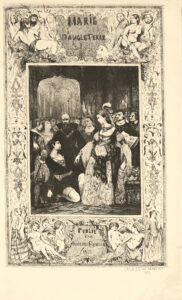Paris, Eugène Renduel, 1833.
8vo of (3) ll. including the engraved frontispiece, IV pp., 214 pp. Bound in contemporary green quarter-morocco, gilt fillet around the covers with corner fleurons, flat spine decorated with fleurons and double gilt fillets, gilt crown in the lower compartment, yellow edges. Contemporary binding.
211 x 129 mm.
First edition “rare and sought after” of this dramatic prose work by the first poet of the French theater (Carteret).
Carteret, I, 406 ; Clouzot, 146 ; Vicaire, Manuel de l’amateur, IV, 280 ; Morgand et Fatout, Bulletin de la Librairie Morgand et Fatout, 3963 ; Solleine, Bibliothèque dramatique, II, 2735, Escoffier, Le Mouvement romantique, 993.
The first edition was printed in 2,000 copies, divided into four sections. The present copy belongs to the first section.
“Printed in 2,000 copies.” Clouzot, 146.
During its first performance on November 6, 1833, the play was a failure. Juliette Drouet, overwhelmed by the critics, decided to abandon the theater.
The edition is adorned with a beautiful frontispiece engraved with etching by Célestin Nanteuil printed on China paper and mounted.
“In London (1553), Queen Mary Tudor, preoccupied with her favorite, the adventurer Fabiano Fabiani, incurs the wrath of the nobles and the hostility of the imperial legate, Simon Renard, who represents the Prince of Spain, the queen’s future husband. But Fabiani betrays her because he loves Jane, a young orphan raised by a brave chiseler named Gilbert who, having adopted her, is preparing to marry her. The favorite secretly learns that Jane is the daughter and heiress of the late Lord Talbot, assassinated, who gave all his property to the sovereign. He then reveals to Gilbert that he is the young girl’s lover. From that moment, the latter dreams of nothing but revenge: he offers his life to Simon Renard on the condition that he promises to avenge him. The generous Gilbert goes to see the queen, already aware of Fabiani’s betrayal. He reveals Jane’s origin and asks that the young girl, restored to her rights, be allowed to marry Fabiani. Mary, on the contrary, has Gilbert and Fabiani arrested as having attempted on her life, then she repents and continually postpones the date of execution of the favorite whom she still loves. As for Gilbert, he waits in silence, thinking that Jane loves the other. For Fabiani, the moment of torture approaches. The queen then charges Jane with helping him escape. But she is transformed: now she falls for the worker, and she helps him escape in place of the treacherous favorite whose death the people, incited by Simon Renard, demand. While Fabiani is led to his execution, the queen again tries to save him: let Gilbert, who is on the run, be secretly replaced by him during the night. But Simon Renard, who sniffed out the deception, decides to save England: it is the favorite who falls. The essential interest of the play should have been in this contrast which, in the heroine’s soul, opposes the aspirations of the queen and the feelings of the woman; but the human element is smothered by the thick intrigue of the melodrama. The last day (titled “Which One?”) owes its profound pathos to the uncertainty that reigns: no one knows whether the favorite or the worker will fall. Thus, more than the offenses to historical truth, the prose wholly geared towards antithesis, and the sentiments of intense sublimity that inspire Gilbert, make this drama one of the most exaggerated examples of Hugo’s theater.…”
Dictionnaire des Œuvres, IV, p. 400.
In his preface, the author cites Shakespeare, Corneille, Molière, and Beaumarchais, among others, as mentors. He dreams his ideal drama: “The purpose of the dramatic poet must always be to achieve both the great and the true, the great within the true, the true within the great. […]. Truth contains morality, greatness contains beauty. […]. The drama as we understand it is human heart, human mind, human passion, human will. […]. This drama would possess such notoriety for loyalty, elevation, usefulness, and good conscience that it would never be accused of seeking effect and clamour, where it would have sought only morality and a lesson. […]. The theater civilizes, explains history, advises the human heart.…”
Victor Hugo (1802-1885) was thirty years old when he wrote Marie Tudor, one of the rare plays he composed in prose. During this decade, he devoted almost exclusively to theater: Hernani, Le Roi s’amuse, Lucrèce Borgia, …
Premiered on November 6, 1833, at the Théâtre de la Porte Saint-Martin, Marie Tudor featured Mlle Georges, Napoleon I’s favorite actress, in the title role, while Juliette Drouet played Jane – a role Victor Hugo had written specifically for her. Though she only appeared once on stage as Jane, she and the playwright would become lovers a few weeks after the premiere, remaining inseparable for nearly 50 years.
A precious wide-margined copy, preserved in its contemporary green quarter-morocco binding.

![Marie Tudor. [dans Œuvres. Drames. VI.]](https://www.camillesourget.com/wp-content/uploads/2025/04/Frontispice-scaled.jpg)
![Marie Tudor. [dans Œuvres. Drames. VI.] - Image 2](https://www.camillesourget.com/wp-content/uploads/2025/04/Titre-6-scaled.jpg)
![Marie Tudor. [dans Œuvres. Drames. VI.] - Image 3](https://www.camillesourget.com/wp-content/uploads/2025/04/Reliure1-scaled.jpg)